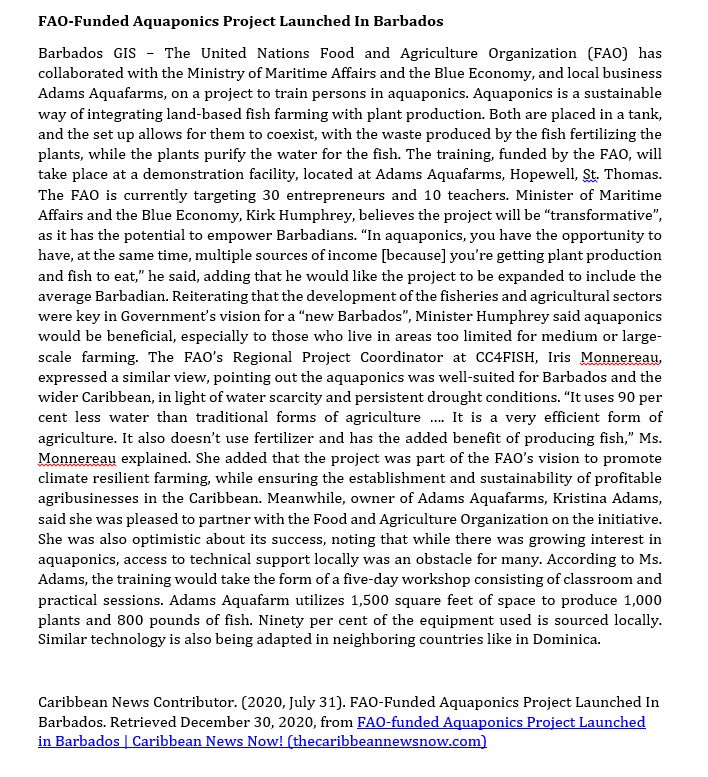Answered step by step
Verified Expert Solution
Question
1 Approved Answer
Instructions Assume that your class group has been selected and hired by the FAO to manage this FAO Funded Aquaponics Project described in the article

Instructions
Assume that your class group has been selected and hired by the FAO to manage this FAO Funded Aquaponics Project described in the article (above). Using expressed and implied information in the article, your project team is required to craft/develop some project documents and plans to help in the overall management of the Aquaponics Project, with specific focus on the components and questions/statements listed below.
Create a partial project schedule using a Gantt Chart (with a minimum of 10 tasks).
FAO-Funded Aquaponics Project Launched In Barbados Barbados GIS - The United Nations Food and Agriculture Organization (FAO) has collaborated with the Ministry of Maritime Affairs and the Blue Economy, and local business Adams Aquafarms, on a project to train persons in aquaponics. Aquaponics is a sustainable way of integrating land-based fish farming with plant production. Both are placed in a tank, and the set up allows for them to coexist, with the waste produced by the fish fertilizing the plants, while the plants purify the water for the fish. The training, funded by the FAO, will take place at a demonstration facility, located at Adams Aquafarms, Hopewell, St. Thomas. The FAO is currently targeting 30 entrepreneurs and 10 teachers. Minister of Maritime Affairs and the Blue Economy, Kirk Humphrey, believes the project will be "transformative", as it has the potential to empower Barbadians. "In aquaponics, you have the opportunity to have, at the same time, multiple sources of income [because] you're getting plant production and fish to eat," he said, adding that he would like the project to be expanded to include the average Barbadian. Reiterating that the development of the fisheries and agricultural sectors were key in Government's vision for a "new Barbados", Minister Humphrey said aquaponics would be beneficial, especially to those who live in areas too limited for medium or largescale farming. The FAO's Regional Project Coordinator at CC4FISH, Iris Monnereau, expressed a similar view, pointing out the aquaponics was well-suited for Barbados and the wider Caribbean, in light of water scarcity and persistent drought conditions. "It uses 90 per cent less water than traditional forms of agriculture .... It is a very efficient form of agriculture. It also doesn't use fertilizer and has the added benefit of producing fish," Ms. Monnereau explained. She added that the project was part of the FAO's vision to promote climate resilient farming, while ensuring the establishment and sustainability of profitable agribusinesses in the Caribbean. Meanwhile, owner of Adams Aquafarms, Kristina Adams, said she was pleased to partner with the Food and Agriculture Organization on the initiative. She was also optimistic about its success, noting that while there was growing interest in aquaponics, access to technical support locally was an obstacle for many. According to Ms. Adams, the training would take the form of a five-day workshop consisting of classroom and practical sessions. Adams Aquafarm utilizes 1,500 square feet of space to produce 1,000 plants and 800 pounds of fish. Ninety per cent of the equipment used is sourced locally. Similar technology is also being adapted in neighboring countries like in Dominica. Caribbean News Contributor. (2020, July 31). FAO-Funded Aquaponics Project Launched In Barbados. Retrieved December 30, 2020, from FAO-funded Aquaponics Project Launched in Barbados | Caribbean News Now! (thecaribbeannewsnow.com)Step by Step Solution
There are 3 Steps involved in it
Step: 1

Get Instant Access to Expert-Tailored Solutions
See step-by-step solutions with expert insights and AI powered tools for academic success
Step: 2

Step: 3

Ace Your Homework with AI
Get the answers you need in no time with our AI-driven, step-by-step assistance
Get Started


